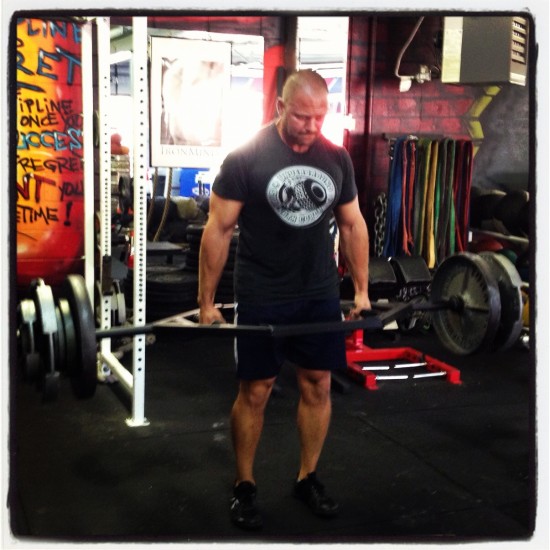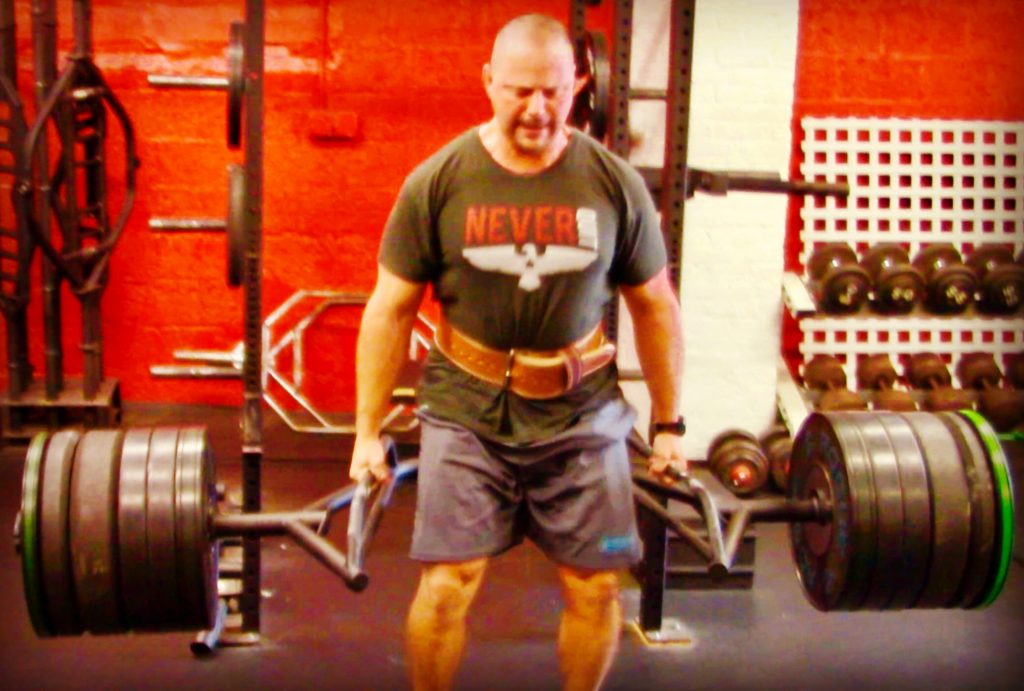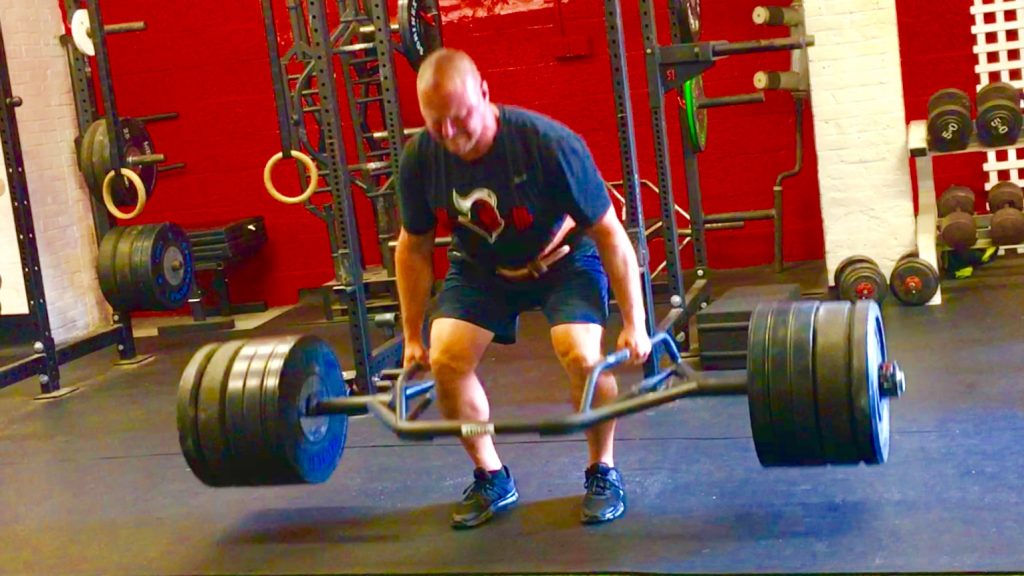
Trap Bar - 5 Benefits & Training Tips
I began using a trap bar around 2002. I still recall the first time I used a trap bar, I saw it collecting dust in the corner of the local gym and I wanted to shake up my deadlift training. So that day I decided to challenge myself and see how heavy I could go on the trap bar.
I worked up to some heavy trap bar deadlifts just shy of the 500 lb mark on the trap bar and decided to experiment some more. I pulled off some weight plates and did trap bar shrugs. After a few hard sets, I pulled off some more weight and performed bent over rows.
The trap bar was not easier than the conventional deadlift, it was merely different. I immediately felt the different effect of the trap bar. Less lower back and more of a squat motion that allowed my posture to be upright and get more leg drive.
In my 17 years of using the trap bar, I never caught myself saying it was better than the straight bar, I simply knew it was a different way to train. The trap bar allowed me to work my body from new angles and that was a plus for me and the athletes I was training.
Since 2002 I’ve seen and used many different trap bars. It has evolved where some are made big enough to be racked on a power rack. Overhead presses with a neutral grip, farmer walks, reverse lunges, rack pulls and more are now options with the trap bar.
If you train athletes or adults, or, you simply want to add more variety to your training, below are 5 benefits & tips to implement the trap bar into your training.

1. Give the Lower Back a Break. If you’ve been consistently deadlifting with a straight bar, every few weeks (unless you’re a powerlifter), you should switch to a Trap Bar Deadlift variation.
The trap bar allows more leg drive and is actually an excellent lift for athletes. There have been research studies performed on the trap bar deadlift in demonstrating athletes don’t tolerate soreness like powerlifters do. The key is to get athletes stronger without interfering with their sports practice.
A sore lower back makes the athlete feel useless. This doesn’t mean we never straight bar deadlift with athletes, it simply means using what we can to keep their sports performance at peak.
2. Strong is Strong. When training for sports or tactical performance, strong is strong. That being said, you want to work with the body from various angles. Athletes need to be strong and prepared for the uncertainties of sports competition. Working the body from all angles helps reduce chances of injury in sports and performance in general.
The Trap Bar Deadlift is more resembling of a squat than it is a conventional deadlift because you get to use a blend of lower body (quads, glutes, hams, low back) where as a conventional deadlift is predominantly the posterior (low back & hamstrings).
You still are getting the hip hinge action and working the posterior with the trap bar deadlift and if you choose to focus more on the posterior, you can perform the RDL (Romanian Deadlift) with the trap bar.
3. Prepare for the Conventional Deadlift. When training athletes and any untrained population (including military, LEO, etc) you want to get the individual strong enough so when it IS time to conventional deadlift, they have built a strength foundation to safely perform the conventional deadlift. The trap bar deadlift is easier to teach & learn, hence it is a great predecessor for the conventional deadlift. Even in my experiences at The D1 level, the majority of athletes were too weak to perform a deadlift with only 135 lbs with a flat back.
I had to build these athletes UP to performing a sumo deadlift and eventually a conventional deadlift. The building process including the trap bar deadlift. Never assume that someone is ready for the conventional deadlift.
I’ve learned that people, including athletes, LEO & Military personnel are weaker than we expect them to be. Training is not supposed to be complicated, but the overabundance of BS out there has led to confusion & ultimately, weaker people.

4. Neutral Handles. The neutral handles are a benefit in giving the biceps a lesser strain compared to the over / under grip of a deadlift, specifically the underhand bicep position. In addition, the neutral grip and the larger rackable trap bar allow you to perform other exercises such as:
- Overhead Presses with a neutral grip (less rotator cuff strain with the elbows in)
- Farmer Walks (excellent for going heavy)
- Reverse Lunges (excellent for varying the loading pattern of your lunges)
Again, the trap bar variations for presses, lunges and carries aren’t better than other variations. They are simply different and should be viewed as another tool in your arsenal of methods to get stronger.
Unless you’re a powerlifter, your performance needs change depending on the situation, especially if you’re an athlete, LEO or Military personnel. You can never predict exactly what will happen in competition or on the job. The trap bar is another tool to strengthen your body from all angles to prepare for the unexpected.
5. High Handles on the Trap Bar. Through the years and decades of training others, I have noticed a considerable decline not just in strength, but in mobility.
The earliest version of the trap bar was not made with high handles. The trap bars of today give you the option to go with high handles or low handles. The high handles help the taller athletes (especially Basketball players) reduce the range of motion.
Sometimes, the lack of ankle mobility & stability make it difficult for the individual to squat down low enough while maintaining proper position in the back and lower body. The high handles also allow you to overload the deadlift compared to the low handles.
When working with beginners and intermediates, use the high handles for the trap bar deadlift. As strength, stability & mobility improve, you can vary as you see fit from low to high handles.
In a nut shell, I love the trap bar. I’ve used it with our youth athletes all the way to our adults. From D1 athletes to our first responders & Military personnel.
I have found that everyone loves having more variety in their training. The variety keeps them excited and it also helps us avoid overuse and stagnating on the straight bar.
Whether you train others as a Coach or you train yourself, get yourself a trap bar! At the end of the day, Strong is STRONG!
Trap Bar Videos:
About The Author
Zach Even-Esh is the founder of The Underground Strength Gym and creator of the Underground Strength Coach Certification with over 1,000 certified coaches around the world. He has been consulting & training athletes and coaches since 2002 on a full time basis. He is a bestselling author of the Encyclopedia of Underground Strength & Conditioning and operates two strength & performance facilities in NJ, The Underground Strength Gym.

